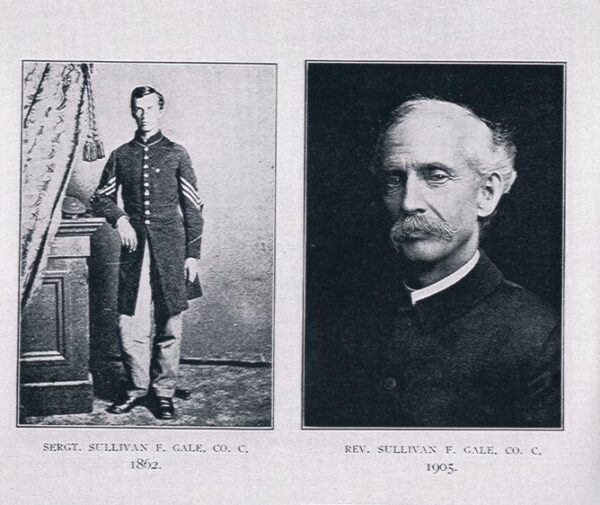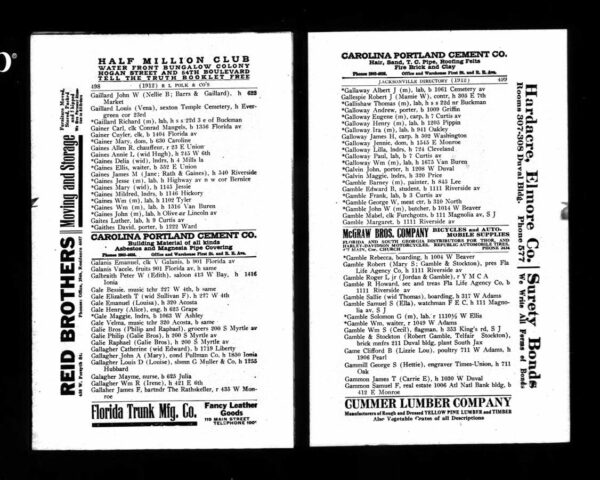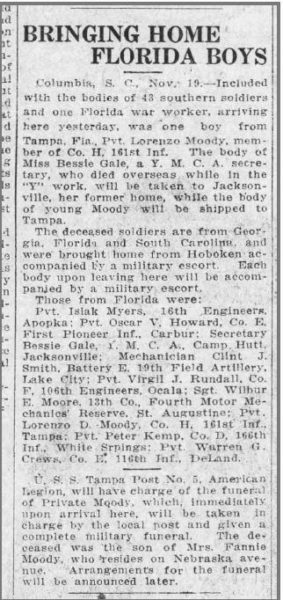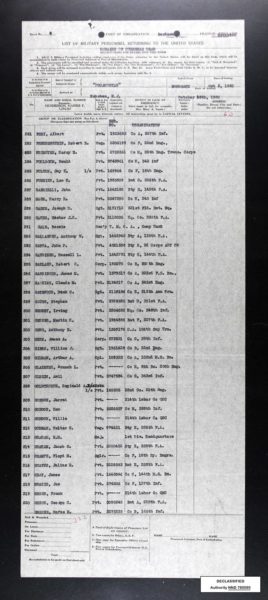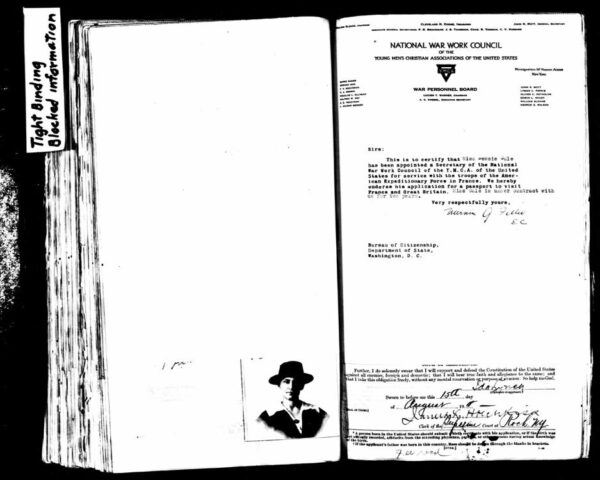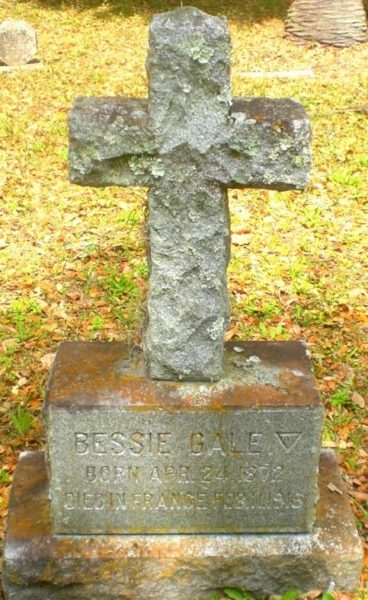Scroll 2 #818
Elizabeth (Bessie) Gale was born in New Marlborough, Massachusetts on April 24, 1872. Her father was Sullivan French Gale (1842-1909), former 1st Sergeant, Co C, 13th Vermont Infantry and a veteran of Gettysburg. A graduate of Barre Academy, the University of Vermont and Union Theological Seminary in New York, he was a Congregational minister in Massachusetts and Wisconsin after the war. He married Elizabeth Taylor Felt (1847-1916) on May 13, 1869, a union that produced five children: Frank Harvey Gale (1871-1954), Bessie; Arthur Sullivan Gale (1877-1964), Louisa Fisk Gale (1879-1963) and Laura Taylor Gale (1885-1886). In 1883, Reverend Gale began working as superintendent of the American Home Missionary Society for Georgia and Florida (and sometimes Alabama and North Carolina), with headquarters in Jacksonville. In this capacity he organized over one hundred churches and co-founded Rollins College, serving as one of its trustees.
In the 1880 Census, the Reverend Gale and his wife, sons Frank and Arthur, and daughters Bessie and Louisa, all lived in Appleton, Wisconsin. Bessie, age 8, and her brothers attended school. Five years later, as reported in the 1885 Florida census, she was attending school in Jacksonville. In the 1900 census, Bessie, then 28 years old, lived with her parents in their home at 1149 Hubbard Street in Jacksonville, along with her sister Louisa, age 20. Bessie reported her occupation as music teacher. The next year Louisa married George Chester Bedell, a prominent attorney. After her father died in 1909, Bessie, age 38, and her widowed mother, Elizabeth, age 63, moved in with the Bedells in their home at 124 West 4th Street, Jacksonville, along with their two children, both under 5, and Mr. Bedell’s father, age 70, from New York. From the early 1900s through 1917, Bessie Gale appears in the Jacksonville city directory, with her occupation listed as music teacher.
Aside from her strong sense of patriotic duty, it is unknown why Bessie Gale decided to volunteer for up to twenty-four months of overseas service as a canteen worker with the American Red Triangle the following year. According to her Y. M. C. A. service card, she was a Congregationalist, with no college degree, but her music skills must have been viewed as particularly desirable for their entertainment value. Being a daughter of a former respected minister also helped. On her passport application she described herself as 5 feet 5 ½ inches tall, with gray eyes and hair, with an “aquiline” nose, and a “prominent” chin and teeth. In order to be sent to France, she had to swear that she did not have any male relatives or acquaintances serving in uniform and promise that she would not attempt to contact them while she was there. Unquestionable loyalty, American citizenship and enthusiasm for winning the war were required by the Government. Proved character, unselfish eagerness to serve, and the ability for teamwork, initiative and adaptability were essential. Her application was witnessed by her brother-in-law, George Chester Bedell, and endorsed by the Personnel Bureau of the Y’s War Work Council. After a thorough investigation, the Military Intelligence Division of the War Department on September 26, 1918, indicated that it had no objection to Bessie going “Over There.” And so, on October 3, 1918, her bags were packed and she was on her way to work with the American Expeditionary Forces (AEF)—some 2 million strong—in France, where the great decisive battles of the World War were being fought. There she would join nearly thirteen thousand other selected American men and women of the Y. M. C. A. whose critical military function was to improve and to maintain morale among the troops.
The Y. M. C. A. endeavored to have the best of American women at the heart of the AEF. Bessie Gale was among some 3,198 women engaged in Y war work in France. In running her canteen, she would be responsible for serving hot or cold drinks, and handing out chocolate, doughnuts, cookies and sandwiches, in veritable restaurant fashion, all free of charge. Canteens served as small post exchanges where cigarettes, cigars, and chewing tobacco were also sold at cost. In addition to large quantities of food, drinks, and smokes, canteens distributed free athletic and entertainment supplies, books, magazines, religious pamphlets and stationery. If she served with combat units, she would work in dressing stations and field hospitals, helping out in whatever way was needed.
The canteen Bessie was assigned was among several Y. M. C. A. huts on the grounds of Camp Hunt between La Teste and Cazaux, in Gironde, the Bordeaux region of Southwestern France. With hundreds of wooden barracks and other buildings, Camp Hunt was a long way from the front, more than 400 miles from Paris. The Bordeaux region was specifically home to the Army’s Service of Supply (SOS), known as Base Section 2, which, in addition to focusing on the logistics of the American war effort, served as a behind-the-lines base network for treating the wounded and those on leave. In addition to the hospitals with a planned capacity of 20,000 beds, Base Section 2 included port facilities, warehouses, ammunition and fuel depots, a seaplane and an airship station, uniform, locomotive, ship and shoe repair shops, a soap, water and electrical plant, bakeries, even a 300-man prisoner of war facility.
In January 1918, the French had transferred the camp to U.S. forces, who had set about improving conditions on the site, which became known as Camp Hunt and was mainly used by the A. E. F. as a school camp for Field Artillery brigades. Upwards of 30,000 artilleryman were stationed here at one time, and each was assigned to one or more intensive courses of training for a period six weeks. There were classes in Gunnery, Telephony, Signalling, Radio, Reconnaissance, Liaison, Camouflage; all supplemented by work in the field and on the range. Practice work with gas masks and marching with masks for a two-week period were features of the training. For recreation in the evening there were occasional movies at the Y. M. C. A. huts, and vaudeville programs put on by members of the various organizations within the camp. Outdoor sports of every sort were indulged in in spare hours. Baseball, football, and soccer were all popular, all organized by the Y.
The Y. M. C. A. had its work cut in providing good, wholesome entertainment for the men stationed at Camp Hunt. Nightly, the wine shops in La Teste, a small village nearest the camp, attracted off-duty throngs. And Arcachon, a seaside resort city about 5 kilometers from Camp Hunt, boasted a casino, a number of hotels, and a splendid promenade along the shore. A certain percentage of the men within each regiment were permitted to go to La Teste or Arcachon each weekend, and both places were within walking distance of Camp Hunt. Or they could pack the trains in standing room only aisles.
Among Y. M. C. A. workers during the Great War by 1920, some 150 died while in service, and 92 of these were casualties overseas. Ten were killed in battle zones (2 were women), 3 men died of wounds, 8 men and 1 woman died of accidents, the remaining 125 (including 22 women) died of disease. Another 128 (5 of whom were women) were wounded or gassed and disabled; 319 were decorated, cited or commended.
On February 22, 1919, Bessie Gale, Y.M.C.A. canteen worker and music teacher from Jacksonville, succumbed to pneumonia and heart failure, a victim of influenza that ravaged Camp Hunt. Six men from one artillery regiment also died from the flu during a two-months stay that winter. Bessie died at Camp Hospital No. 29, located on the outskirts of Camp Hunt. During its existence since the previous February, the hospital admitted a total of 6,897 surgical and medical cases; the greatest number of patients in hospital at one time was 1,017, on September 23, 1918, exceeding its bed capacity of 960. These were wounded troops from forward areas in the U.S.-led offensive in the Battle of Saint-Mihiel.
Bessie was buried in Grave 29, Section A, Officer’s Section, of the American Cemetery in Talence, Gironde, created in April 1918, which contained the graves of both Canadian and American soldiers. Disinterred on September 23, 1920, she was returned from Bordeaux to Hoboken, New Jersey, onboard the Pocahontas on October 5. Her flag-draped casket arrived by train in Jacksonville on November 11, 1920, received by her brother-in-law, George Chester Bedell. She was reburied in Evergreen Cemetery, Jacksonville, the following day.
Before-after photos of S. F. Gale, 1862-1905.
Bessie Gale, music teacher. 1912 Jacksonville City Directory.
Tampa Times 11/19/1920.
Remains of “Overseas Dead” onboard the Pocahontas transport ship. #291 was Bessie Gale’s coffin.
Bessie Gale’s passport application with YMCA endorsement.
Bessie Gale’s Y. M. C. A. personnel file.
Bessie Gale’s grave marker, Evergreen Cemetery, Jacksonville.
(Note the triangle beside Bessie Gale’s name, a symbol of the Y.M.C.A.)



